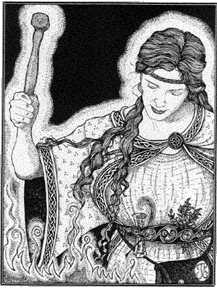

| HOME | ABOUT Blackthorne | THE LINKS | THE PODIUM |
 Mara Freeman :Kindling the Celtic Spirit-Harper San Francisco 2000 The 10th century Cormac’s Glossary describes her as the daughter of the Daghda, the “Great God” of the Tuatha de Danaan. He calls her a “woman of wisdom…a goddess whom poets adored, because her protection was very great and very famous." Since the discipline of poetry, filidhect, was interwoven with seership, Brigid was seen as the great inspiration behind divination and prophecy, the source of oracles. She is said to have had two sisters: Brigid the Physician and Brigid the Smith, but it is generally thought that all three were aspects of the one goddess of poetry, healing, and smithcraft. Elsewhere she is described as the patron of other vital crafts of early Celtic society: dying, weaving and brewing. A goddess of regeneration and abundance, she was greatly beloved as a provider of plenty who brought forth the bounties of the natural world for the good of the people. She is closely connected with livestock and domesticated animals. She had two oxen called Fea and Feimhean who gave their names to a plain in Co. Carlow and one in Tipperary. She was also the guardian of Torc Triath, king of the wild boar, who gave his name to Treithirne, a plain in West Tipperary. These three totem animals used to raise a warning cry if Ireland was in danger. Some Irish rivers bear her name, as do places as far apart as Breconshire in Wales, Brechin in Scotland and Bregenz in Austria, which was once the capital of the Brigantii tribe. This tribe was under the tutelage of the goddess Brigantia, who is thought to be another aspect of Brigid. The most powerful political unit of Celtic-speaking Britain, the Brigantii mostly held sway in Northern England, where place-names and rock-carvings still echo the presence of their mother-goddess. Mara Freeman's Webstite:Imbolchttp://www.celticspirit.org/imbolc.htm |
Links to info on Brigid Brigid:Our Bright Fire Brigid: Flame of Two Eternities :ADF : : : Links to info on St.BrigidSt Brigid Muire na nGael:First Woman of Ireland Brigid's Place: St Brigid of Ireland:Miniature Stories of the Saints |
| HOME | ABOUT Blackthorne | THE LINKS | THE PODIUM |